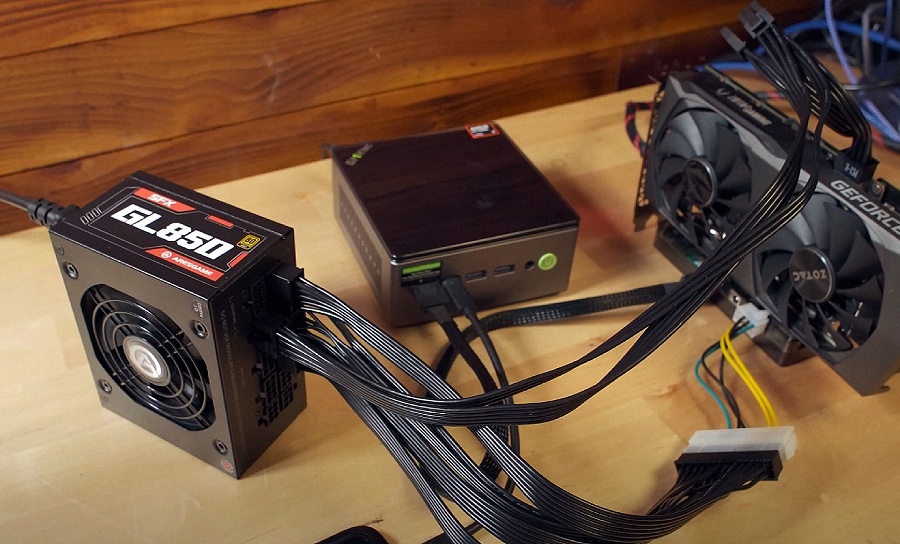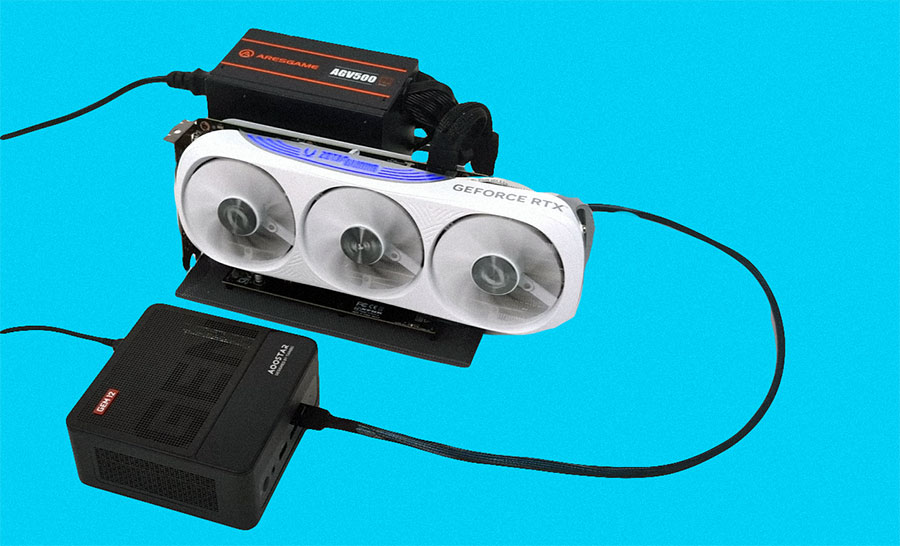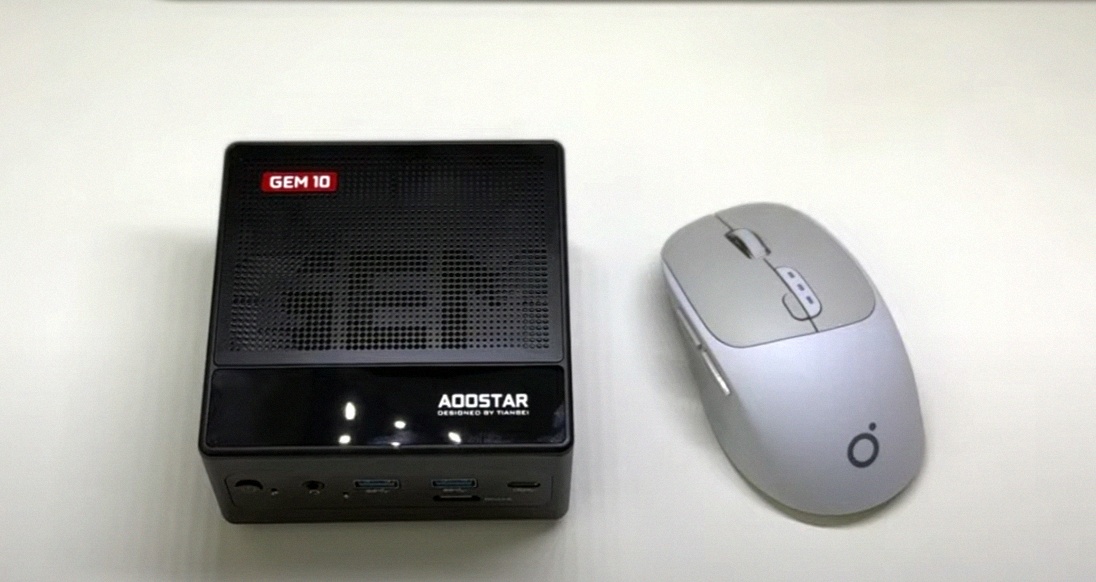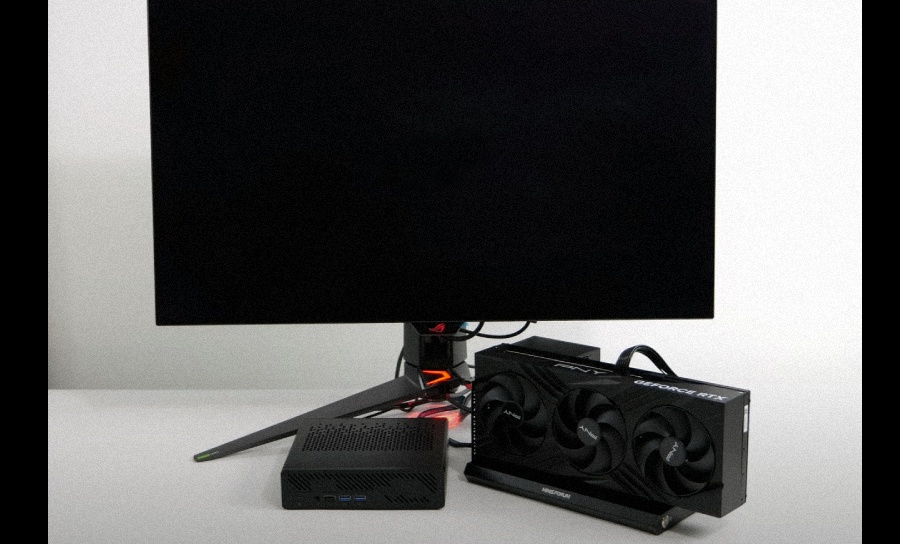Best Mini PC with OCuLink Port for eGPU

Over the past few months, I’ve been exploring Mini PCs with OCuLink connectivity, and it’s been an interesting ride. This technology is quietly making a big impact on compact computing, especially for those who need high-speed external GPU connectivity. After testing various setups and seeing how they perform under real workloads, I’ve come to appreciate OCuLink as a valuable feature for small form factor PCs.
There was a time when choosing a compact PC meant sacrificing serious GPU power, but that’s no longer the case. I’ve put these Mini PC setups through their paces – running everything from LLM servers (Llama, DeepSeek) and diffusion models (Flux.1, Stable Diffusion) to demanding games – and the performance has been surprisingly solid. In my testing, a Mini PC with OCuLink comes remarkably close to a full-sized desktop, just in a much smaller footprint.
For those more interested in Mini PCs with built-in mobile GPUs, I’ve also tested some of the top models from NVIDIA and AMD, which take a different approach to delivering compact performance. Interestingly, even budget-friendly options like N100 Mini PCs are proving how far small form-factor systems have come
During testing, my focus was on space efficiency and ease of setup. I wanted a compact yet powerful system with 24GB of VRAM, without the hassle of complicated assembly.
What is OCulink?
OCuLink, short for Optical Copper Link, is a PCIe-over-cable technology designed to provide ultra-fast data transfer speeds by establishing a direct PCIe connection to an external GPU. Unlike USB 4.0 or Thunderbolt 4, which cap out at around 40 Gbps, OCuLink leverages PCIe 4.0 x4 to offer up to 64 Gbps of bandwidth. That’s a significant leap, especially for tasks that demand low latency and high throughput, like connecting external GPUs (eGPUs) or high-speed NVMe storage arrays.
For mini PCs, OCuLink is a game-changer. It allows these tiny computers to tap into the full potential of desktop-grade hardware, like an RTX 3090 or 4090 GPU, without the bulk of a traditional tower. And here’s the kicker: in some cases, it’s even more cost-effective than building a full desktop setup. Plus, it’s surprisingly accessible for non-technical users. No need to fiddle with internal components or worry about proprietary hardware – just plug and play.
Best mini PC models with OCuLink
After testing multiple options, the AOOSTAR GEM 12 with Ryzen 9 6900HX CPU, stands out as the best mini PC with OCuLink. It features a PCIe 4.0 x4 OCuLink port, allowing GPU expansion, and 3 high-speed m.2 NVMe slots for storage. With a compact yet powerful design, it’s equipped with a high-performance CPU, efficient cooling, and robust connectivity options. Currently the model ahs the best price to performance ratio – the model can be found for under $400 with 16GB of ram and 512 GB NVMe drive.
| Attribute | AOOSTAR GEM12 6900HX | AOOSTAR GEM10 7840HS | GMKtec Nucbox K8 Plus | Minisforum MS-A1 9600X |
|---|---|---|---|---|
| Socket | FP7 | FP7 FP7r2 FP7 | FP7 FP7r2 FP8 | AM5 |
| CPU Gen | Zen 3+ | Zen 4 | Zen 4 | Zen 5 |
| CPU | Ryzen r9 6900HX | Ryzen r7 7840HS | Ryzen r7 8845HS | Ryzen r5 9600X |
| Cores/Threads | 8/16 | 8/16 | 8/16 | 6/12 |
| iGPU | RDNA2 680M | RDNA3 780M | RDNA3 780M | Radeon Ryzen 9000 |
| Outlink | PCIE 4.0 x4 | PCIE 4.0 x4 | PCIE 4.0 x4 | PCIE 4.0 x4 |
| Displays | 4 | 3 | 4 | 3 |
| Ram Slots | 2 | Soldered | 2 | 2 |
| Max RAM GB | 64 | 32 | 96 | 96 |
| Max Speed MT/s | 4800 | 6400 | 5600 | 5200 |
| Max Drives | 2 | 3 | 2 | 4 |
| Max NVMe | 2 | 3 | 2 | 3.25 |
| Gen 4 NVMe | 2 | 3 | 2 | 2.25 |
| Gen 3 NVMe | 0 | 0 | 0 | 1 |
| USB4 | 1 | 1 | 2 | 1 |
| HDMI 2.1 | 1 | 2 | 1 | 1 |
| Ethernet Ports | 2 (2.5GB) | 3 (2.5GB) | 4 (2.5GB) | 5 (2.5GB) |
| PSU (W) | 120 | 240 | ||
| Warranty yrs | 1 | 1 | 1 | 2 |
Later, I will go over additional hints, tips, and key factors to look for when choosing an OCuLink-enabled device. But now, let’s look at some of the tested models in more detail.
AOOSTAR GEM 12 Mini PC
The AOOSTAR GEM 12 is an impressive mini PC that exceeds expectations across multiple use cases. While many compact systems struggle to balance performance, features, and build quality, the Gem 12 nails it. With a slick design reminiscent of Intel NUCs, a solid metal chassis, and thoughtful port selection—including OCuLink for high-speed external GPU support—this machine is well-equipped for both general computing and high-performance workloads.
Powered by the Ryzen 9 6900HX with 32 GB of DDR5 5600 (up to 128 GB) system memory, it delivers strong CPU and integrated graphics performance, and memory overclocking options help squeeze out even more power. It also includes dual M.2 Gen 4.0 x4 NVMe slots, a well-ventilated design with efficient cooling, and impressively low fan noise under load—especially in balanced mode. AOOSTAR 6900HX Mini PC supports WiFi 6(AX200) and the latest Bluetooth 5.2.
The system’s idle power draw sits at 10 watts, while the maximum power consumption, as measured at the wall, reaches 101 watts. This power efficiency makes it a great option for users looking for a balance between performance and energy consumption.
Performance benchmarks confirm that the Gem 12 holds its own, with solid results across CPU, GPU, and storage tests.
Synthetic benchmarks
| Test type | Result |
|---|---|
| Cinebench R23 (Single-Core) | 1640 points |
| Cinebench R23 (Multi-Core) | 13100 points |
| SSD Read/Write Speed | 5010.22 MB/s (Read) / 2495.44 MB/s (Write) |
Gaming benchmarks
Gaming benchmarks are done with EVGA RTX 3090 FTW3 ULTRA.
| Game | Settings | Resolution | Average FPS |
|---|---|---|---|
| Cyberpunk 2077 (Ultra) | Ultra | 1440p | 80.12 |
| Red Dead Redemption 2 (Ultra) | Ultra | 1440p | 86.32 |
| Fortnite (High) | High | 1440p | 142.04 |
| God of War (Ultra) | Ultra | 1440p | 107.67 |
LLM inference speed benchmarks
We tested the AOOSTAR GEM 12 for local LLM inference using an EVGA RTX 3090 FTW3 ULTRA via OCuLink, running llama.cpp with a 512-token context window. The system had no trouble keeping up with inference tasks, handling text generation with low latency and smooth performance.
| Model | Parameters | Quantization | Speed t/s | Context Size |
|---|---|---|---|---|
| Qwen 2.5 32B | 32B | 4-bit | 32.12 | 512 tokens |
| DeepSeek R1 Distill Qwen 32B | 32B | 4-bit | 36.66 | 512 tokens |
| Gemma 2 27B | 27B | 4-bit | 39.33 | 512 tokens |
| Mistral Small 24B 2501 | 24B | 4-bit | 42.45 | 512 tokens |
The inclusion of OcuLink proves to be a major advantage over USB 4, offering noticeably higher bandwidth and smoother external GPU performance. The are 4 dedicated OCuLink PCIe lanes that do not interfere with the NVMe.
While wireless range is underwhelming and the glued-on rubber feet make opening the unit more cumbersome, these are minor drawbacks in an otherwise well-rounded package. Whether you’re looking for a compact workstation, an eGPU-friendly mini PC, or a general-purpose machine with strong expandability, the Stars Gem 12 delivers.
AOOSTAR GEM 10 Mini PC
The Aoostar Gem10 is an impressively compact Mini PC that brings serious performance and expandability to the table, thanks to its AMD Ryzen 7 7840HS APU and integrated Radeon 780M graphics. What sets it apart from other Mini PCs is the inclusion of an OCuLink port, allowing for high-bandwidth external GPU (eGPU) support with minimal bottlenecking compared to USB4 or Thunderbolt 4.
The system supports three PCIe 4.0 NVMe SSDs, runs LPDDR5-6400 RAM (soldered up to 32GB) for improved memory bandwidth, and features a well-designed cooling system that keeps thermals in check even under high loads. The I/O selection includes USB 4, multiple USB 3.2 ports, dual 2.5GbE, and HDMI outputs.
The AOOSTAR GEM 10 has an idle power draw of 9 watts, while under load (CPU + GPU) in performance mode, it reaches a maximum of 106 watts as measured at the wall. This efficient power usage ensures a solid balance between performance and energy consumption, making it a reliable choice for various workloads.
Synthetic benchmarks
| Test type | Result |
|---|---|
| Cinebench R23 (Single-Core) | 1822 points |
| Cinebench R23 (Multi-Core) | 16156 points |
| SSD Read/Write Speed | 5213.72 MB/s (Read) / 2688.11 MB/s (Write) |
Gaming benchmarks
Gaming benchmarks are done with EVGA RTX 3090 FTW3 ULTRA.
| Game | Settings | Resolution | Average FPS |
|---|---|---|---|
| Cyberpunk 2077 (Ultra) | Ultra | 1440p | 84.13 |
| Red Dead Redemption 2 (Ultra) | Ultra | 1440p | 84.88 |
| Fortnite (High) | High | 1440p | 143.11 |
| God of War (Ultra) | Ultra | 1440p | 109.23 |
LLM inference speed benchmarks
For the AOOSTAR GEM 10, we used the sameEVGA RTX 3090 FTW3 ULTRA and llama.cpp setup with a 512-token context window. The system handled local LLM inference smoothly, with response times meeting expectations for the RTX 3090. Loading times were slightly longer due to the x4 PCIe lane limitation, but once the model was fully loaded into VRAM, inference speeds remained consistent and reliable.
| Model | Parameters | Quantization | Speed t/s | Context Size |
|---|---|---|---|---|
| Qwen 2.5 32B | 32B | 4-bit | 34.18 | 512 tokens |
| DeepSeek R1 Distill Qwen 32B | 32B | 4-bit | 38.22 | 512 tokens |
| Gemma 2 27B | 27B | 4-bit | 41.22 | 512 tokens |
| Mistral Small 24B 2501 | 24B | 4-bit | 46.40 | 512 tokens |
When tested with its integrated Radeon 780M graphics, the Gem10 delivers solid gaming performance at 1140p with lower settings, reaching 63 FPS in Shadow of the Tomb Raider and over 70 FPS in Cyberpunk 2077 with FSR enabled. However, the real potential is unlocked with an OCuLink eGPU, such as the Radeon RX 7600M XT in the GPD G1 enclosure. This setup pushes Cyberpunk 2077 to ultra settings at 1080p with an average of 85 FPS, and dramatically improves synthetic benchmark scores. While OCuLink isn’t hot-swappable like USB4, its 63Gbps bandwidth provides a significant boost over Thunderbolt 4’s 40Gbps, making it an ideal solution for users looking for a highly portable yet powerful gaming or workstation setup.
GMKtec K8 Plus Mini PC
The GMKtec K8 Plus is a compact yet surprisingly capable Mini PC, powered by the Ryzen 7 8845HS (basically 7840HS with NPU) processor and integrated Radeon 780M graphics. Equipped with 32GB of DDR5 RAM and a 1TB PCIe 4.0 NVMe SSD, it delivers strong multitasking performance and efficient storage speeds. What sets it apart, however, is the inclusion of OCuLink, allowing for seamless external GPU integration.
Power efficiency is commendable, with an idle draw of 11W and peak consumption of 110W.
Testing the unit with a powerful 24GB GPU through OcuLink transformed it into a high-performance workstation, demonstrating its potential for AI workloads, local LLM inference, and computationally demanding applications. The cooling solution is well-designed, with ample ventilation and easy accessibility for upgrades and maintenance. Windows 11 Pro comes pre-installed, and the device supports a robust selection of connectivity options, including USB4 and dual HDMI 2.1 for high-resolution multi-display setups.
Synthetic benchmarks
| Test type | Result |
|---|---|
| Cinebench R23 (Single-Core) | 1721 points |
| Cinebench R23 (Multi-Core) | 15267 points |
| SSD Read/Write Speed | 6912.18 MB/s (Read) / 6002.13 MB/s (Write) |
Gaming benchmarks
Gaming benchmarks are done with EVGA RTX 3090 FTW3 ULTRA.
| Game | Settings | Resolution | Average FPS |
|---|---|---|---|
| Cyberpunk 2077 (Ultra) | Ultra | 1440p | 79.11 |
| Red Dead Redemption 2 (Ultra) | Ultra | 1440p | 84.55 |
| Fortnite (High) | High | 1440p | 138.14 |
| God of War (Ultra) | Ultra | 1440p | 104.22 |
LLM inference speed benchmarks
Testing the GMKtec K8 Plus for local LLM inference was done using an EVGA RTX 3090 FTW3 ULTRA connected via OcuLink, with llama.cpp. The model was configured with a 512-token context window. Performance benchmarks showed that the system, when paired with the RTX 3090, handled inference smoothly, delivering low latency and stable throughput.
| Model | Parameters | Quantization | Speed t/s | Context Size |
|---|---|---|---|---|
| Qwen 2.5 32B | 32B | 4-bit | 31.55 | 512 tokens |
| DeepSeek R1 Distill Qwen 32B | 32B | 4-bit | 33.47 | 512 tokens |
| Gemma 2 27B | 27B | 4-bit | 35.90 | 512 tokens |
| Mistral Small 24B 2501 | 24B | 4-bit | 41.77 | 512 tokens |
Beyond general productivity, the K8 Plus excels as a compact server solution, handling tasks such as self-hosted AI models and media transcoding with ease. When paired with an external GPU, it significantly boosts performance for machine learning workloads, making it an attractive option for developers working on AI-driven applications. Storage expansion is straightforward, and its efficient power consumption makes it a viable 24/7 home server. Network connectivity is solid, but the Wi-Fi module could benefit from an upgrade to Wi-Fi 6E for better wireless performance. Overall, the K8 Plus offers an impressive balance of power and versatility at its price point, particularly for users looking to harness external GPU acceleration for demanding workloads.
Minisforum MS-A1 Mini PC
Minisforum’s latest Mini PC, the MS-A1, is an impressive step forward in compact workstation computing, standing out as the most powerful model in our Best Mini PCs with OCuLink roundup. Unlike other systems in our list that rely on mobile processors, this machine is built around a full-fledged 65watt desktop-class AMD Ryzen 9 9600X CPU, delivering performance uplift over mobile parts.
With an AM5 socket, a robust cooling solution, and a 65W TDP limit, the MS-A1 offers desktop-level performance in a compact form factor, making it a versatile choice for AI workloads, gaming, and home lab setups. Storage flexibility is another strong suit, with four M.2 slots – including high-speed PCIe Gen 4 support – providing ample expansion options. Dual 2.5GbE networking ensures solid connectivity for server applications, while the inclusion of an OCuLink port sets it apart, enabling high-bandwidth external GPU support.
Synthetic benchmarks
| Test type | Result |
|---|---|
| Cinebench R23 (Single-Core) | 2398 points |
| Cinebench R23 (Multi-Core) | 18256 points |
| SSD Read/Write Speed | 5444.72 MB/s (Read) / 2588.51 MB/s (Write) |
Gaming benchmarks
Gaming benchmarks are done with EVGA RTX 3090 FTW3 ULTRA.
| Game | Settings | Resolution | Average FPS |
|---|---|---|---|
| Cyberpunk 2077 (Ultra) | Ultra | 1440p | 83.19 |
| Red Dead Redemption 2 (Ultra) | Ultra | 1440p | 85.45 |
| Fortnite (High) | High | 1440p | 142.13 |
| God of War (Ultra) | Ultra | 1440p | 105.83 |
LLM inference speed benchmarks
For the MS-A1, we again used EVGA RTX 3090 FTW3 ULTRA and llama.cpp setup with a 512-token context window. The system handled local LLM inference smoothly, with response times meeting expectations for the RTX 3090. Loading times were slightly longer due to the x4 PCIe lane limitation, but once the model was fully loaded into VRAM, inference speeds remained consistent and reliable.
| Model | Parameters | Quantization | Speed t/s | Context Size |
|---|---|---|---|---|
| Qwen 2.5 32B | 32B | 4-bit | 33.38 | 512 tokens |
| DeepSeek R1 Distill Qwen 32B | 32B | 4-bit | 37.12 | 512 tokens |
| Gemma 2 27B | 27B | 4-bit | 42.55 | 512 tokens |
| Mistral Small 24B 2501 | 24B | 4-bit | 47.41 | 512 tokens |
Performance testing confirms the advantage of the Ryzen 9 9600X, outpacing high-end Intel mobile CPUs like the Core i9-13900H in both compute and graphics benchmarks. The integrated Radeon 780M GPU proves competitive, but real potential is unlocked through OCuLink. Paired with a RTX 3090 via the OCuLink, we observed a dramatic leap in graphics performance, and AI performance.
Why OcuLink Matters for Mini PCs
If you’re wondering why OCuLink is such a big deal, let’s break it down.
Performance Advantages
OCuLink’s 64 Gbps bandwidth (thanks to PCIe 4.0 x4) leaves USB4 and Thunderbolt 4 in the dust. This extra headroom is crucial for tasks like gaming, 3D rendering, or running local LLMs, where every millisecond counts. For example, pairing a mini PC with an RTX 4090 via Oculink lets you harness nearly the full power of the GPU, with only a 10-15% performance loss in gaming compared to a direct PCIe connection. And for local LLM servers? That loss is practically negligible—once the model is loaded, you won’t even notice it.
Use Cases
While I was testing with my main use – local LLM server and Flux.1 Dev ComfyUI workflow – thre are other applications that this mini pc setup can handle.
- External GPUs for Gaming and Rendering: OCuLink makes it easy to connect a high-end GPU to a mini PC, turning it into a gaming or rendering beast.
- Compact Local LLM Servers: Running powerful language models like LLaMA 3 or DeepSeek locally requires a beefy GPU with at least 24GB of VRAM. OCuLink paired with an RTX 3090 or 4090 is one of the cheapest and easiest ways to build a local LLM server.
- High-Speed NVMe Storage: Need to work with massive datasets or 8K video files? OCuLink can handle multiple NVMe drives in a RAID array without breaking a sweat.
Compare this to other options: buying an OEM small form factor (SFF) PC often means you can’t slot a full-size GPU, and tower PCs with proprietary PSUs can be a headache to upgrade. OCuLink sidesteps these issues entirely, offering a clean, modular solution.
Key Factors to Consider When Buying
Before diving into the world of OCuLink-enabled mini PCs, there are a few things to keep in mind.
Performance Loss with High-End GPUs
Currently, most OcuLink implementations provide only x4 PCIe lanes, which can bottleneck high-end GPUs like the RTX 3090, 4090, and future 5090, leading to an estimated 10-15% performance loss in gaming and GPU-intensive tasks. However, for mid-range or lower-power GPUs, the impact is much smaller and often negligible.
For LLM inference, the lane limitation has no effect on actual performance. The only noticeable difference is in model loading times, which may be slightly longer. Once the model is loaded into VRAM, the GPU runs at full power, delivering the same inference speeds as a full PCIe x16 setup.
OcuLink Port Version: PCIe 3.0 vs. 4.0
Not all OCuLink ports are created equal. While PCIe 3.0 offers decent bandwidth (around 32 Gbps), PCIe 4.0 doubles that to 64 Gbps. For high-end GPUs or NVMe storage, PCIe 4.0 is a must. Always check the specs to ensure you’re getting the latest version.
OcuLink Adapters and Docking Stations
Most mini PCs with OCuLink will require an adapter or docking station to connect your GPU or storage. These accessories are widely available, but make sure they’re compatible with your setup. A docking station can make the whole process cleaner and more organized, though it’s not strictly necessary.
Power Supply Considerations
Don’t forget: your GPU will need its own power supply. Most mini PCs can’t provide enough juice for a desktop GPU, so you’ll need an external PSU. This can make the setup a bit janky if you’re not using a docking station, but it’s a small price to pay for the performance boost.
Allan Witt
Allan Witt is Co-founder and editor in chief of Hardware-corner.net. Computers and the web have fascinated me since I was a child. In 2011 started training as an IT specialist in a medium-sized company and started a blog at the same time. I really enjoy blogging about tech. After successfully completing my training, I worked as a system administrator in the same company for two years. As a part-time job I started tinkering with pre-build PCs and building custom gaming rigs at local hardware shop. The desire to build PCs full-time grew stronger, and now this is my full time job.1 Comment
Submit a Comment
Related
Desktops
Dell refurbished desktop computers
If you are looking to buy a certified refurbished Dell desktop computer, this article will help you …
Guides
Dell Outlet and Dell Refurbished Guide
For cheap refurbished desktops, laptops, and workstations made by Dell, you have the option to use …
Guides
Refurbished, Renewed, Off Lease
When you are looking for refurbished computer, you often see – certified, renewed, and off-lease placed in …
Laptops
Excelent Refurbished ZenBook Laptops
If you are looking for a compact ultrabook and a reasonable price, consider a refurbished Asus Zenbook …




I’m seriously considering building a compact workstation for AI development, and mini PC wwith OCuLink seems like great option. Your benchmarks on the AOOSTAR GEM 12 with the RTX 3090 for LLM inference are particularly compelling. However, you mentioned a 10-15% performance hit with high-end GPUs due to the x4 PCIe lanes. Have you experimented with different GPUs to see how this performance penalty scales with different power levels? For example, would a 3070 or a 4070 show a less significant drop? I’m also curious about the thermal performance of the Mini PCs, especially under sustained high loads like those seen in LLM training.